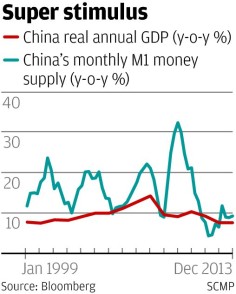Macroscope | Reform or stagnate is China's choice as stimulus stops working
Monetary stimulus may bring temporary relief to the mainland's battered financial system, but only reform can help increase economic activity

If insanity means doing the same thing again and again but expecting a different result, the world's central banks may be getting near that point. The People's Bank of China in particular faces a stark situation - monetary stimulus no longer works.
This month, the PBOC both injected US$80 billion into five national banks and lowered a guiding interest rate to a 45-month low. This may temporarily soothe a battered financial system; it will not increase economic activity.
The interest rate cut assumes officially set rates are important. Privileged enterprise - usually but not always state-owned - get loans rolled over almost at will. Remaining borrowers can see wildly uneven financing costs. In both cases, the nominal interest rate means little.

At the system level, the mainland's M2 broad money approached US$20 trillion at the end of August. The liquidity injection is equivalent to less than half of 1 per cent of a money supply increasing about 13 per cent annually. The five recipient banks have stated assets in excess of US$10 trillion, so it is only two drops in that specific bucket.
The lack of response to all this liquidity is seen in the M1 narrow money. M1 is currency in circulation plus demand deposits - money actually deployed.
M1 growth was faster than official real gross domestic product growth from 1998 to 2008, until the financial crisis hit and the two briefly equalised. The mainland then engaged in its destructive super stimulus and M1 growth soared. In 2011, however, the M1 line fell below announced gross domestic product.
